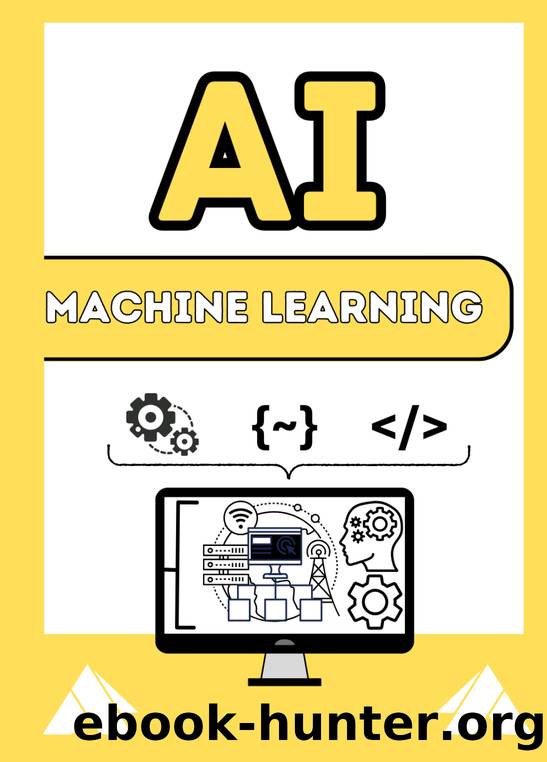AI Machine Learning: AI, Data Science, and the book is designed for beginners, with live coding examples inside the book so you can learn easily and quickly. by Pulok Md

Author:Pulok, Md
Language: eng
Format: epub
Published: 2024-01-02T00:00:00+00:00
ML Deep Learning
1.Machine learning (ML) deep learning is a subfield of ML that focuses on using artificial neural networks to model and solve complex problems. Deep learning algorithms, particularly deep neural networks, are designed to automatically learn and represent hierarchical patterns and features from data.
2.Neural Networks: Deep learning revolves around artificial neural networks, which are computational models inspired by the structure and functioning of the human brain. These networks consist of layers of interconnected nodes (neurons) that process information.
3.Deep Neural Networks: The "deep" in deep learning refers to the depth of the neural network, meaning it has multiple layers (typically more than one hidden layer) between the input and output layers. Deep neural networks can learn complex representations of data.
4.Feature Hierarchy: Deep learning excels at automatically learning hierarchical representations of features from raw data. Lower layers capture simple and local features, while higher layers combine these features to form more abstract and complex representations.
1.End-to-End Learning: Deep learning models are capable of end-to-end learning, meaning they can learn to perform a task directly from raw data without relying on manual feature engineering. This is particularly advantageous for tasks where the optimal features are not well-defined.
2.Training with Back propagation: Deep learning models are trained using the back propagation algorithm. During training, the model makes predictions, and the difference between predictions and actual outcomes is used to adjust the model's parameters iteratively. This process minimizes the error and improves the model's performance.
3.Convolutional Neural Networks (CNNs): CNNs are a type of deep neural network designed for processing structured grid-like data, such as images. They use convolutional layers to automatically learn spatial hierarchies of features.
4.Recurrent Neural Networks (RNNs): RNNs are specialized for sequential data, such as time series or natural language. They have memory cells that allow them to capture dependencies and patterns across time steps.
5.Auto encoders: Auto encoders are unsupervised learning models used for feature learning and dimensionality reduction. They consist of an encoder and a decoder, with the encoder learning a compressed representation of the input data.
6.Transfer Learning: Transfer learning is a technique in deep learning where a pre-trained model on one task is adapted to another task. This approach leverages the knowledge gained from a source task to improve performance on a target task, especially when labeled data for the target task is limited.
1.Reinforcement Learning: Deep learning is also integrated with reinforcement learning for tasks involving decision-making and control. Deep reinforcement learning combines deep neural networks with reinforcement learning principles to learn policies for making sequential decisions.
2.Training on Large Datasets: Deep learning models often require large amounts of labeled data for effective training. The availability of big data has played a crucial role in the success of deep learning applications.
3.Distributed Computing: Training deep learning models can be computationally intensive. Distributed computing, using multiple GPUs or specialized hardware like TPUs, is often employed to accelerate the training process.
4.Deep Learning Frameworks: Various deep learning frameworks, such as TensorFlow and PyTorch, provide tools and abstractions for building and training complex neural network architectures. These frameworks facilitate the implementation of deep learning models without having to start from scratch.
Download
This site does not store any files on its server. We only index and link to content provided by other sites. Please contact the content providers to delete copyright contents if any and email us, we'll remove relevant links or contents immediately.
Algorithms of the Intelligent Web by Haralambos Marmanis;Dmitry Babenko(8305)
Test-Driven Development with Java by Alan Mellor(6763)
Data Augmentation with Python by Duc Haba(6680)
Principles of Data Fabric by Sonia Mezzetta(6426)
Learn Blender Simulations the Right Way by Stephen Pearson(6325)
Microservices with Spring Boot 3 and Spring Cloud by Magnus Larsson(6198)
Hadoop in Practice by Alex Holmes(5964)
Jquery UI in Action : Master the concepts Of Jquery UI: A Step By Step Approach by ANMOL GOYAL(5811)
RPA Solution Architect's Handbook by Sachin Sahgal(5594)
Big Data Analysis with Python by Ivan Marin(5382)
The Infinite Retina by Robert Scoble Irena Cronin(5286)
Life 3.0: Being Human in the Age of Artificial Intelligence by Tegmark Max(5153)
Pretrain Vision and Large Language Models in Python by Emily Webber(4347)
Infrastructure as Code for Beginners by Russ McKendrick(4112)
Functional Programming in JavaScript by Mantyla Dan(4041)
The Age of Surveillance Capitalism by Shoshana Zuboff(3960)
WordPress Plugin Development Cookbook by Yannick Lefebvre(3824)
Embracing Microservices Design by Ovais Mehboob Ahmed Khan Nabil Siddiqui and Timothy Oleson(3627)
Applied Machine Learning for Healthcare and Life Sciences Using AWS by Ujjwal Ratan(3601)
